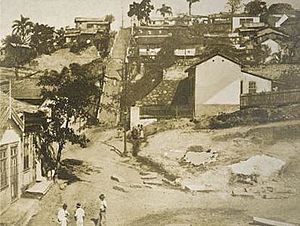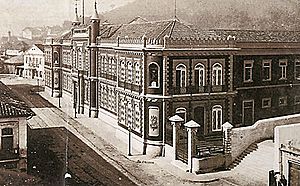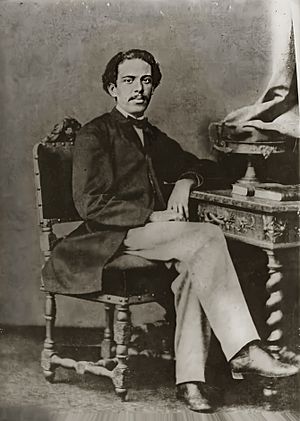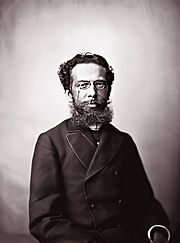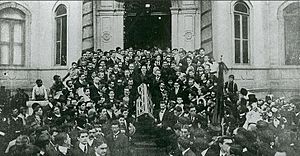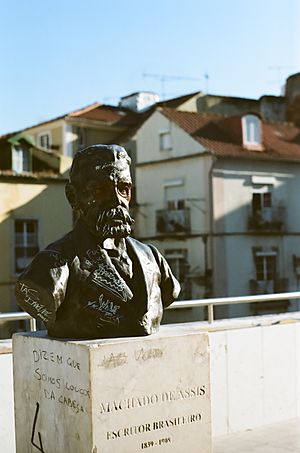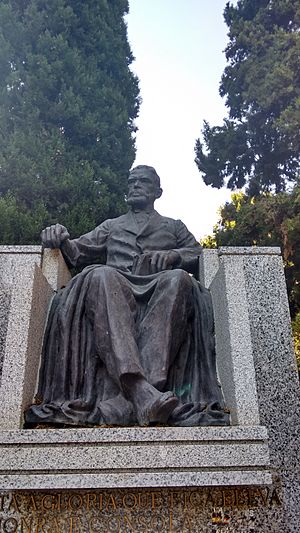Machado de Assis facts for kids
Quick facts for kids
Machado de Assis
|
|
|---|---|
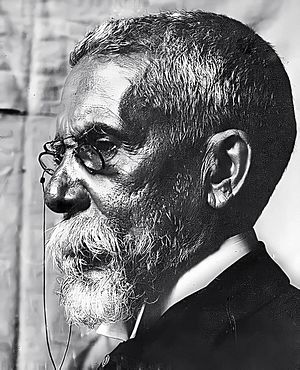
Machado de Assis in 1904.
Brazilian National Archives |
|
| 1st Academic of the 23rd chair of the Brazilian Academy of Letters | |
| In office 28 January 1897 – 29 September 1908 |
|
| Preceded by | Position established José de Alencar (patron) |
| Succeeded by | Lafayette Rodrigues Pereira |
| President of the Brazilian Academy of Letters | |
| In office 28 January 1897 – 29 September 1908 |
|
| Preceded by | Position established |
| Succeeded by | Ruy Barbosa |
| Personal details | |
| Born |
Joaquim Maria Machado de Assis
21 June 1839 Rio de Janeiro, Empire of Brazil |
| Died | 29 September 1908 (aged 69) Rio de Janeiro, Brazil |
| Spouses | Carolina de Novais (1869–1904; her death) |
| Occupation | Novelist, short story writer, poet, literary critic |
| Period | 1864–1908 |
| Movement | Romanticism, Realism |
| Influences |
See list
Camões • Vieira • Mattos • Alencar • Almeida Garrett • Schopenhauer • Spinoza • Victor Hugo • Poe • La Rochefoucauld • Goethe • Swift • Sterne • Lucian of Samosata • Voltaire • Shakespeare • Dante • Cervantes
|
| Influenced |
See list
John Barth • Carlos Drummond de Andrade • Cyro dos Anjos • Graciliano Ramos • Murilo Rubião • João Guimarães Rosa • Jorge Amado • Érico Verissimo • José Saramago • Rubem Braga • João Cabral de Melo Neto • Vinicius de Moraes • Mário de Andrade • Manuel Bandeira • Chico Buarque de Holanda • Jorge de Lima • Joaquim Nabuco • Gilberto Freire • Gustavo Corção
|
| Other names | Machado, "The Warlock from Cosme Velho" |
| Signature |  |
Joaquim Maria Machado de Assis, also known as Machado de Assis, was a famous Brazilian writer. He was born on June 21, 1839, and passed away on September 29, 1908. Many people consider him the greatest writer in Brazilian literature.
Machado de Assis was a pioneer in writing novels, poems, plays, and short stories. Even though he was very talented, he wasn't widely known outside Brazil during his lifetime. In 1897, he helped create the Brazilian Academy of Letters and became its first President. He was also very good at languages, teaching himself French, English, German, and Greek later in life.
Machado was born in Rio de Janeiro into a family that faced many challenges. He didn't have much formal schooling and never went to university. But he was very smart and taught himself a lot. He worked hard to improve his life, taking on different public jobs. He also became famous by publishing his first poems and stories in newspapers. His writing helped shape the "realism" movement in Brazil. He was known for his cleverness and for looking closely at society.
Some of his most famous books include Dom Casmurro (1899), Memórias Póstumas de Brás Cubas (also called Epitaph of a Small Winner), and Quincas Borba (also known as Philosopher or Dog?). In 1893, he wrote "A Missa do Galo" ("Midnight Mass"), which many believe is the best short story in Brazilian literature. A famous American literary expert, Harold Bloom, even put Machado de Assis on his list of 100 literary geniuses.
Contents
Machado's Early Life
Birth and Childhood
Joaquim Maria Machado de Assis was born on June 21, 1839, in Rio de Janeiro. At that time, Rio de Janeiro was the capital of the Empire of Brazil. His father, Francisco José de Assis, was a wall painter whose parents had been freed from slavery. His mother, Maria Leopoldina da Câmara Machado, was a Portuguese washerwoman.
He was born in a country house owned by Dona Maria José de Mendonça Barroso Pereira. She was kind to his parents and let them live there. Dona Maria José became Joaquim's godmother. His godfather was Joaquim Alberto de Sousa da Silveira, and Joaquim was named after both of them. Machado had a sister, but she passed away when she was young. Joaquim went to a public school but wasn't a top student. While helping at church, he met Father Silveira Sarmento, who became his Latin teacher and a good friend.
Teenage Years and First Steps in Writing
When Joaquim was ten, his mother died. His father then moved to São Cristóvão and later married Maria Inês da Silva in 1854. Joaquim was able to attend classes at a girls' school because his stepmother worked there making candies. At night, he learned French from a baker who was an immigrant.
As a teenager, he met Francisco de Paulo Brito, who owned a bookstore, a newspaper, and a printing press. On January 12, 1855, when Joaquim was 15, Francisco de Paula published Joaquim's poem Ela ("Her") in his newspaper, Marmota Fluminense. The next year, Joaquim got a job as a typographer's apprentice at the Imprensa Oficial (the Official Press). The director, Manuel Antônio de Almeida, encouraged him to write. There, he also met Francisco Otaviano and Quintino Bocaiúva, who would later become famous.
Becoming a Writer
Early Career and Learning
In 1858, Francisco Otaviano hired Machado to work as a proofreader at the newspaper Correio Mercantil. Machado kept writing for Marmota Fluminense and other newspapers. He didn't earn much money and lived a simple life. Sometimes, he could only afford to eat once a day.
Around this time, he became friends with the writer and politician José de Alencar, who taught him English. From English books, he was inspired by writers like Laurence Sterne, William Shakespeare, and Jonathan Swift. Years later, he learned German, and in his old age, he learned Greek. In 1860, he was invited to work at the newspaper Diário do Rio de Janeiro. Machado loved theater and wrote several plays for a short time. His friend Bocaiúva told him, "Your works are meant to be read and not played." He started to become known and signed his writings as J. M. Machado de Assis, which is how he became famous.
Machado's father, Francisco de Assis, died in 1864. Machado learned about it from others. He dedicated his poetry book "Crisálidas" to his parents. Around this time, the Liberal Party came to power, and Machado hoped for a good job. To his surprise, Emperor Dom Pedro II hired him as an assistant director in the Diário Oficial in 1867. The Emperor also honored him by making him a knight. In 1888, Machado was made an officer of the Order of the Rose.
Marriage and Family Life
In 1868, Machado met Carolina Augusta Xavier de Novais, who was five years older than him. She was the sister of his colleague Faustino Xavier de Novais. Machado was shy, short, and thin, and he had a stammer. But he was also very smart and well-educated.
He married Carolina on November 12, 1869. Her parents and siblings didn't approve because Machado had a mixed racial background, and she was of European descent. Despite this, they had a happy marriage for 35 years. They did not have any children.
Machado's Famous Works
Machado moved up in his government job, first in the Agriculture Department, and three years later, he became a section head. He published two poetry books, Falenas in 1870 and Americanas in 1875. They weren't very popular, so he started writing other types of literature.
He wrote five romantic novels: Ressurreição, A Mão e Luva, Helena, and Iaiá Garcia. These books were popular with readers, but some literary experts didn't think they were very good. Machado often had epilepsy attacks, especially after his old friend José de Alencar died. This made him feel sad and think a lot about death.
His next book, Memórias Póstumas de Brás Cubas (Posthumous Memoirs of Brás Cubas), was different. It had a more thoughtful and realistic tone. Many people consider it a masterpiece. By the late 1880s, Machado was widely known as a great writer.
Machado and Society
Even though Machado was against slavery, he never spoke out about it in public. He also avoided talking about politics. Some people, like the abolitionist José do Patrocínio, criticized him for staying out of political discussions, especially about ending slavery. They also criticized him for marrying a white woman.
Machado was surprised when the monarchy was overthrown on November 15, 1889. He didn't support the idea of a republic because he believed in a monarchy and admired Emperor Pedro II. He saw the Emperor as "a humble, honest, well-learned, and patriotic man." When people came to his office to remove the Emperor's picture, the usually shy Machado bravely told them, "The picture got in here by an order and it shall leave only by another order."
After Brazil became a republic, Machado became even more observant of Brazilian society. From then on, he wrote what are considered "not only the greatest novels of his time, but the greatest of all time of Brazilian literature." Books like Quincas Borba (Philosopher or Dog?) (1891), Dom Casmurro (1899), Esaú e Jacó (1904), and Memorial de Aires (1908) were very successful with both readers and critics. In 1893, he published "A Missa do Galo" ("Midnight Mass"), which is thought to be his best short story.
Later Life and Legacy
Machado de Assis, along with other writers and thinkers, founded the Brazilian Academy of Letters. He was its first president from 1897 until he died in 1908. For many years, he asked the government to give the Academy a proper building, which he finally got in 1905. In 1902, he moved to a directing role in the accounting department of the Ministry of Industry.
His wife, Carolina Novais, passed away on October 20, 1904, after 35 years of a happy marriage. Machado felt very sad and lonely after her death. He died on September 29, 1908.
Machado's Writing Style
Machado's writing style is very special. Many literary experts have tried to describe it since 1897. He is considered by many to be the greatest Brazilian writer ever, and one of the world's best novelists and short story writers. His newspaper articles are not as famous. His poems are sometimes hard to understand because they use strong words.
The American literary expert Harold Bloom included Machado de Assis in his list of the 100 greatest literary geniuses. This list also includes writers like Dante, Shakespeare, and Cervantes. Bloom believes Machado is the greatest black writer in Western literature. However, in Brazil, Machado is often seen as having a mixed racial background.
Machado's works have been studied by experts in many countries. Critics have different ideas about his writing. Some say he was against "realism" and wanted to show that reality isn't always what it seems. Others believe his work truly described Brazilian life, but in a new and bold way. Most critics agree that he used new writing methods to show the problems and contradictions in his society.
Machado's writing style has inspired many Brazilian writers. His books have been made into TV shows, plays, and movies. In 1975, the "Machado de Assis Commission" published special editions of his works in 15 volumes. His main books have been translated into many languages. Famous writers like Salman Rushdie and Carlos Fuentes, and even film director Woody Allen, have said they love his stories.
Despite efforts by well-known thinkers like Susan Sontag and Harold Bloom, Machado's books haven't sold a lot in English-speaking countries. He is still not as well-known as some other Latin American writers. In his books, Machado often talks directly to the reader, which is a unique way to connect with them.
List of Works
- 1860 – Hoje avental, amanhã luva (play)
- 1861 – Desencantos (play)
- 1863 – O caminho da porta, and O protocolo (two plays)
- 1864 – Quase ministro (play)
- 1864 – Crisálidas (poetry)
- 1866 – Os deuses de casaca (play)
- 1870 – Falenas (poetry)
- 1870 – Contos Fluminenses (collection of short stories)
- 1872 – Ressurreição (Resurrection; novel)
- 1873 – Histórias da meia-noite (collection of short stories)
- 1874 – A Mão e a Luva (The Hand and the Glove; novel)
- 1875 – Americanas (poetry)
- 1876 – Helena (novel)
- 1878 – Iaiá Garcia (novel)
- 1878 – O bote de rapé (play)
- 1881 – Tu, só tu, puro amor (play)
- 1881 – Memórias Póstumas de Brás Cubas (The Posthumous Memoirs of Bras Cubas, also known in English as Epitaph of a Small Winner; novel)
- 1881 – O Alienista (The Psychiatrist, or The Alienist; novella)
- 1882 – Papéis avulsos (collection of short stories, including "O Alienista")
- 1884 – Histórias sem data (collection of short stories)
- 1891 – Quincas Borba (also known in English as Philosopher or Dog?; novel)
- 1896 – Várias histórias (collection of short stories)
- 1899 – Páginas recolhidas (collection of short stories, including The Case of the Stick and the play Não consultes médico)
- 1899 – Dom Casmurro (novel)
- 1901 – Ocidentais (poetry)
- 1901 – Poesias Completas (complete poetry)
- 1904 – Esaú e Jacó (Esau and Jacob; novel)
- 1906 – Lição de botânica (play)
- 1906 – Relíquias de Casa Velha (collection of short stories)
- 1908 – Memorial de Aires (Counselor Ayres' Memorial; novel)
Posthumous Works (Published After His Death)
- 1910 – Teatro Coligido (collected plays)
- 1910 – Crítica
- 1914 – A Semana (collection of articles)
- 1921 – Outras Relíquias (collection of short stories)
- 1921 – Páginas Escolhidas (collection of short stories)
- 1932 – Novas Relíquias (collection of short stories)
- 1937 – Crônicas (articles)
- 1937 – Crítica Literária
- 1937 – Crítica Teatral
- 1937 – Histórias Românticas
- 1939 – Páginas Esquecidas
- 1944 – Casa Velha
- 1956 – Diálogos e Reflexões de um Relojoeiro
- 1958 – Crônicas de Lélio
Translations by Machado de Assis
- 1861 – Queda que as mulheres têm para os tolos, from the original De l'amour des femmes pour les sots, by Victor Hénaux
- 1865 – Suplício de uma mulher, from the original Le supplice d'une femme, by Émile de Girardin
- 1866 – Os Trabalhadores do Mar, from the original Les Travailleurs de la mer, by Victor Hugo
- 1870 – Oliver Twist, from the original Oliver Twist; or, the Parish Boy's Progress, by Charles Dickens
- 1883 – O Corvo, from The Raven, a famous poem by Edgar Allan Poe
Collected Works (All His Writings Together)
- 1920 – Obras Completas. Rio de Janeiro: Livraria Garnier (20 vols.)
- 1962 – Obras Completas. Rio de Janeiro: W.M. Jackson (31 vols.)
- 1997 – Obras Completas. Rio de Janeiro: Editora Globo (31 vols.)
- 2006 – Obras Completas. Rio de Janeiro: Nova Aguilar (3 vols.)
Works Translated into English
- 1921 – Brazilian Tales. Boston: The Four Seas Company (London: Dodo Press, 2007).
- 1952 – Epitaph of a Small Winner. New York: Noonday Press (London: Hogarth Press, 1985; republished as The Posthumous Memoirs of Brás Cubas: A Novel. New York: Oxford University Press, 1997; Epitaph of a Small Winner. New York: Farrar, Straus & Giroux, 2008; UK: Bloomsbury Publishing, 2008).
- 1953 – Dom Casmurro: A Novel. New York: Noonday Press (Berkeley: University of California Press, 1966; republished as Dom Casmurro. Lord Taciturn. London: Peter Owen, 1992; Dom Casmurro: A Novel. New York: Oxford University Press, 1997).
- 1954 – Philosopher or Dog? New York: Avon Books (republished as The Heritage of Quincas Borba. New York: W.H. Allen, 1957; New York: Farrar, Straus and Giroux, 1992; republished as Quincas Borba: A Novel. New York: Oxford University Press, 1998).
- 1963 – The Psychiatrist, and Other Stories. Berkeley: University of California Press.
- 1965 – Esau and Jacob. Berkeley: University of California Press.
- 1970 – The Hand & the Glove. Lexington: University Press of Kentucky.
- 1972 – Counselor Ayres' Memorial. Berkeley: University of California Press (republished as The Wager: Aires' Journal. London: Peter Owen, 1990; also republished as The Wager, 2005).
- 1976 – Yayá Garcia: A Novel. London: Peter Owen (republished as Iaiá Garcia. Lexington: University Press of Kentucky, 1977).
- 1977 – The Devil's Church and Other Stories. Austin: University of Texas Press (New York: HarperCollins Publishers Ltd, 1987).
- 1984 – Helena: A Novel. Berkeley: University of California Press.
- 2008 – A Chapter of Hats and Other Stories. London: Bloomsbury Publishing.
- 2012 – The Alienist. New York: Melville House Publishing.
- 2013 – Resurrection. Pennsylvania: Latin American Literary Review Press.
- 2013 – The Alienist and Other Stories of Nineteenth-century Brazil. Indianapolis: Hackett Publishing.
- 2014 – Ex Cathedra: Stories by Machado de Assis — Bilingual Edition. Hanover, Conn.: New London Librarium.
- 2016 – Miss Dollar: Stories by Machado de Assis — Bilingual Edition. Hanover, Conn.: New London Librarium.
- 2018 – Trio in A-Minor: Five Stories by Machado de Assis—Bilingual Edition. Hanover, Conn.: New London Librarium.
- 2018 - The Collected Stories of Machado de Assis. New York : Liveright & Company.
- 2018 – Good Days!: The Bons Dias! Chronicles of Machado de Assis (1888-1889) — Bilingual Edition. Hanover, Conn.: New London Librarium.
Awards and Recognition
Titles and Positions
- Founding member of the Brazilian Academy of Letters (1896–1908).
- President of the Brazilian Academy of Letters (1897–1908).
Honors and Medals
 Empire of Brazil: Knight of the Order of the Rose (1867).
Empire of Brazil: Knight of the Order of the Rose (1867). Empire of Brazil: Officer of the Order of the Rose (1888).
Empire of Brazil: Officer of the Order of the Rose (1888).
Special Tributes
On June 21, 2017, Google celebrated Machado de Assis's 178th birthday with a special Google Doodle on their homepage.
Images for kids
See also
 In Spanish: Joaquim Machado de Assis para niños
In Spanish: Joaquim Machado de Assis para niños


